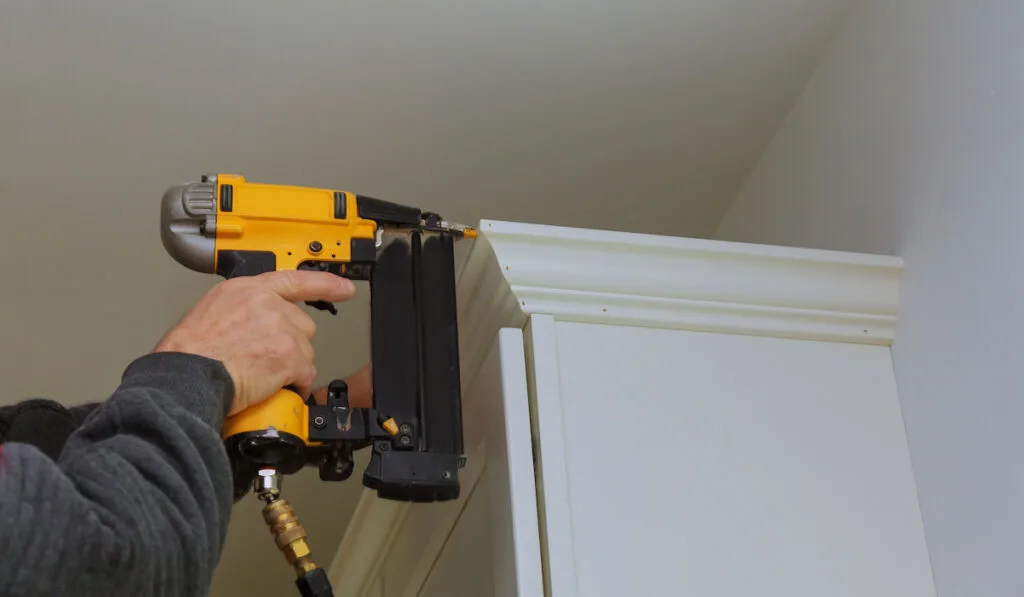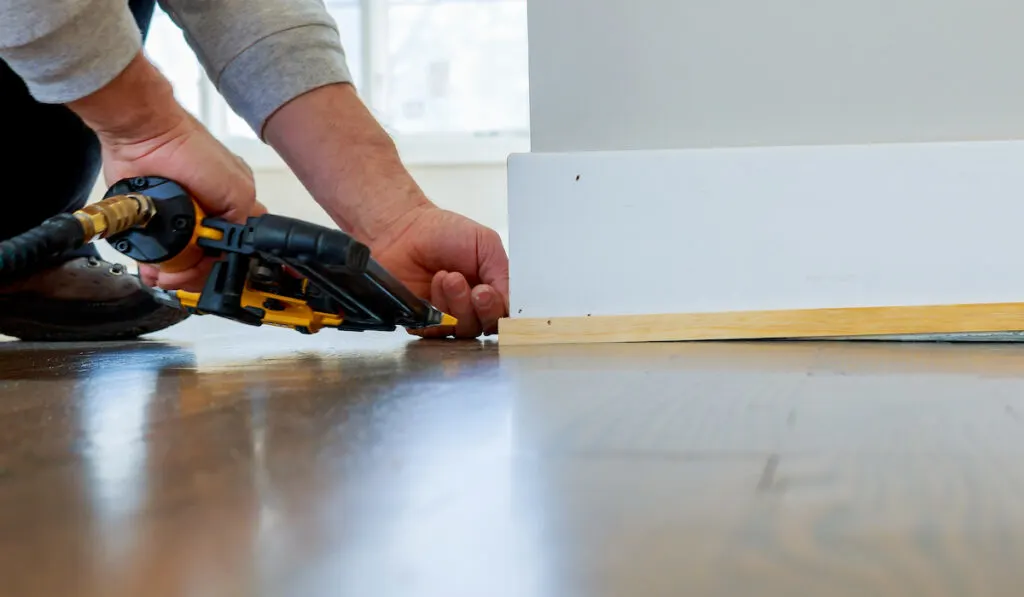*This post may have affiliate links, which means I may receive commissions if you choose to purchase through links I provide (at no extra cost to you). As an Amazon Associate, I earn from qualifying purchases. Please read my disclaimer for additional details.
Getting into home improvement and do-it-yourself projects (DIY) can be not only a fun pastime but also a potentially financially rewarding undertaking, depending on the nature and quality of the work you perform. However, in order to do a project successfully, you will need to be equipped with the right tools. Chief among these are nailers, essential for proper fastening.

What are the different types of nailers? Types of nailers can loosely be categorized into nailers for heavy-duty projects and nailers used for finishing:
| Heavy Duty Nailers | Finishing Nailers |
|---|---|
| Framing Nailers | Palm Nailers |
| Roofing Nailers | Pin Nailers |
| Flooring Nailers | |
| Siding Nailers |
There are a number of different types of nailers, or nail guns, on the market, depending on the project and the nail.
When choosing the type of nailer you want to purchase, you need a clear idea of the project you plan on performing, the type of materials you will need fastened, and the kind of nail you will use to hold your work together.
Once this is established, there is a specific nailer for every occasion.
Table of Contents
Nailers for Heavy-Duty Projects
Just like table saws have replaced handheld versions and drills have replaced screwdrivers for big-time projects that require a high volume of work to be performed quickly, nailers have replaced hammers for most major construction projects.
Nailers allow workers to execute their labor quicker and with greater accuracy than the manual hammer/nail option.
When looking for a nailer to use for heavy-duty projects, classified as work that requires many nails that are expected to be strong, durable, and long-lasting, there are four main categories of nail guns that may fit the bill:
We will look into each of these unique nailer types and talk about when to use each.
Framing Nailers

Framing nailers are often used to handle large projects where thick, sturdy wood needs to be attached quickly. These types of nailers will be used when framing a house, building a deck, or constructing a fence (source).
This is often the most heavy-duty nailer and will accommodate nails up to 3 ½ inches. It is ideal for attaching 2 x 4s, one of the most fundamental lumber cuts used in major construction projects.
Framing nailers look a lot like drills, can hold a large volume of nails, and require a pull of a trigger to set nails into wood.
Flooring Nailers
Manually setting nails into hundreds of square feet of hardwood floor is an extremely tedious task.
As the name implies, flooring nailers were invented to make this difficult task much less of a chore.
While the flooring nailer will not use as thick of nails as framing nailers, often using finer finishing nails to secure flooring that already interlocks to a certain degree, it gets classified with heavy-duty nailers due to the sheer volume of nails it will be required to handle.

Flooring nailers also differ from framing nailers in that they do not look like drills and are not operated by triggers, but instead by the strike of a rubber mallet to set the nail.
When operating a flooring nailer, the following steps will need to be taken:
- Line the area to be floored
- Set a perimeter for the floored area (this will often have to be done manually)
- Butt the flooring of choice up to the perimeter
- Place the tongue of the flooring nailer on top of the flooring, with the nozzle pressed firmly against the side of the flooring
- Strike the actuator to set the nail
- Slide the flooring nailer down the line, setting a new nail approximately every 10 inches
Roofing Nailers
Roofing nailers are similar to framing nailers in that they are shaped like a drill and set their nails upon the pull of a trigger.
One difference is that they are specifically designed to drive a specific type of nail–the roofing nail. Roofing nails have disproportionately large, round heads and heavier shafts for their length (source). They are typically three-quarters of an inch to one and a half inches in length.

This allows roofing nails to hold roofing materials in place, specifically those materials made of composition and asphalt. Other common roofing materials that need to be fastened may include fiberglass shingles and insulation board.
However, the most significant difference between roofing nailers and most other nailers is that they are designed to drive coil nails (coil roofing nails).
Coil nails are essentially a long string of nails, connected by a thin wire, that are wrapped tightly around each other to form a round coil, which is loaded into the roofing nailer’s circular magazine.
This allows for the roofing nailer to hold proportionally more nails in its magazine than other heavy-duty mailers.
Holding capacity is an essential function for roofing nailers. Roofs require a large number of nails, just like any other heavy-duty project.
However, it is not always easy to bring buckets of spare nails up onto slanted roofs. The coil nail feature of roofing nailer magazines makes it so that workers have to make minimal trips up and down the ladder.

Siding Nailers
Siding nailers are very similar to both framing nailers and roofing nailers in that they look like drills and set nails with a trigger pull.
When hanging siding, it is often necessary to have a fastener that can penetrate a stud, so 2 ½ inch nails are often the most desirable for siding projects.
Siding nailers can operate with stick-fed nails, in which a straight line of connected nails is fed into the gun or the coil nails mentioned in the previous section, but coil nails are usually the more desirable choice.
While it is true that framing nailers or roofing nailers perform basically the same functions as siding nailers and can be used for siding projects, the devil is in the details, and there are three main characteristics that distinguish nailers designed specifically for siding:
- Nose at a 90° angle – while driving nails at multiple angles is often advantageous for framing projects, siding nails always need to be driven at a right angle so that they are flush with the siding and leave no protruding edges
- Lightweight – as siding projects require that your nailer be held in front of you for long periods of time, siding nailers are designed as the most lightweight of the heavy-duty nailer options
- Padded nose – unlike framing nailers, which may leave small impressions on the wood it is fastening, siding nailers have protected noses so that sharp edges do not come into contact with the siding and cause any damage
Nailers Used for Finishing
Unlike the heavy-duty nailers that are required for quickly and accurately driving a large number of nails capable of holding sturdy materials, there are other nailers used for more intricate projects.
Palm Nailers
Palm nailers are a lot like framing mailers–only a miniature version. They work in much the same manner as framing nailers, only on a much smaller scale.
These nailers fit in your palm, are held in place with a strap, and are often battery operated.
Palm nailers are great when doing smaller projects or trying to fit nails into tight spots. They can also be advantageous to those with injury or other physical disabilities, as they are capable of driving full-size nails without causing nearly as much muscular endurance to operate.
Pin Nailers or Finishing Nailers
Pin nailers are often used for finishing in carpentry work and are the smallest, most intricate nailers on the market.
Pin nailers are used to drive small, headless nails that look like pins.
These nails are often used in conjunction with some other kind of fastener and are usually meant as support until glue or some other adhesive dries, since larger nails may split the wood and cause damage to the project.
Pin nailers would most likely be used when making cabinets or adding delicate trim to a piece of woodwork.
These are also often called “Finishing Nailers”.
So is a Nailer right for your project?
With so many nailers available there is no doubt that there is one just right for your project. Once you try one it is very likely that you will never return to the old method of hammer & nails!
